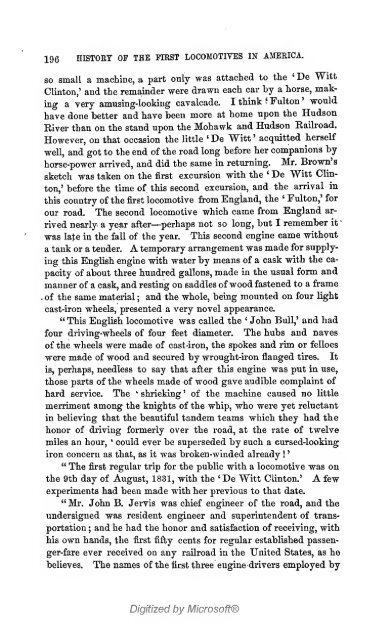The history of the first locomotives in America. From original ...
The history of the first locomotives in America. From original ...
The history of the first locomotives in America. From original ...
You also want an ePaper? Increase the reach of your titles
YUMPU automatically turns print PDFs into web optimized ePapers that Google loves.
196<br />
HISTORY OF THE FIRST LOCOMOTIVES IS AMERICA.<br />
SO small a mach<strong>in</strong>e, a part only was attached to <strong>the</strong> ' De "Witt<br />
Cl<strong>in</strong>ton,' and <strong>the</strong> rema<strong>in</strong>der were drawn each car by a horse, mak<strong>in</strong>g<br />
a very amus<strong>in</strong>g-look<strong>in</strong>g cavalcade. I th<strong>in</strong>k i Fulton would<br />
'<br />
have done better and have been more at home upon <strong>the</strong> Hudson<br />
Eiver than on <strong>the</strong> stand upon <strong>the</strong> Mohawk and Hudson Railroad,<br />
However, on that occasion <strong>the</strong> little 'De Witt' acquitted herself<br />
well, and got to <strong>the</strong> end <strong>of</strong> <strong>the</strong> road long before her companions by<br />
horse-power arrived, and did <strong>the</strong> same <strong>in</strong> return<strong>in</strong>g. Mr. Brown's<br />
sketch was taken on <strong>the</strong> <strong>first</strong> excursion with <strong>the</strong> ' De Witt Cl<strong>in</strong>-<br />
ton,' before <strong>the</strong> time <strong>of</strong> this second excursion, and <strong>the</strong> arrival <strong>in</strong><br />
this country <strong>of</strong> <strong>the</strong> <strong>first</strong> locomotive from England, <strong>the</strong><br />
' Fulton,' for<br />
our road. <strong>The</strong> second locomotive which came from England ar-<br />
rived nearly, a year after— ^perhaps not so long, but I remember it<br />
was late <strong>in</strong> <strong>the</strong> fall <strong>of</strong> <strong>the</strong> year. This second eng<strong>in</strong>e came withput<br />
a tank or a tender. A temporary arrangement was made for supply-<br />
<strong>in</strong>g this English eng<strong>in</strong>e with water by means <strong>of</strong> a cask with <strong>the</strong> capacity<br />
<strong>of</strong> about three hundred gallons, made <strong>in</strong> <strong>the</strong> usual form and<br />
manner <strong>of</strong> a cask, and rest<strong>in</strong>g on saddles <strong>of</strong> wood fastened to a frame<br />
. <strong>of</strong> <strong>the</strong> same material ; and <strong>the</strong> whole, be<strong>in</strong>g mounted on four light<br />
cast-iron wheels, presented a very novel appearance.<br />
" This English locomotive was called <strong>the</strong> ' John Bull,' and had<br />
four driv<strong>in</strong>g-wheels <strong>of</strong> four feet diameter. <strong>The</strong> hubs and naves<br />
<strong>of</strong> <strong>the</strong> wheels were made <strong>of</strong> cast-iron, <strong>the</strong> spokes and rim or felloes<br />
were made <strong>of</strong> wood and secured by wrought-iron flanged tires. It<br />
is, perhaps, needless to say that after this eng<strong>in</strong>e was put <strong>in</strong> use,<br />
those parts <strong>of</strong> <strong>the</strong> wheels made <strong>of</strong> wood gave audible compla<strong>in</strong>t <strong>of</strong><br />
hard service. <strong>The</strong> ' shriek<strong>in</strong>g ' <strong>of</strong> <strong>the</strong> mach<strong>in</strong>e caused no little<br />
merriment among <strong>the</strong> knights <strong>of</strong> <strong>the</strong> whip, who were yet reluctant<br />
<strong>in</strong> believ<strong>in</strong>g that <strong>the</strong> beautiful tandem teams which <strong>the</strong>y had <strong>the</strong><br />
honor <strong>of</strong> driv<strong>in</strong>g formerly over <strong>the</strong> road, at <strong>the</strong> rate <strong>of</strong> twelve<br />
miles an hour, ' could ever be superseded by such a cursed-look<strong>in</strong>g<br />
iron concern as that, as it was broken-w<strong>in</strong>ded already !<br />
" <strong>The</strong> <strong>first</strong> regular trip for <strong>the</strong> public with a locomotive was on<br />
<strong>the</strong> 9th day <strong>of</strong> August, 1831, with <strong>the</strong> 'De Witt Cl<strong>in</strong>ton.' A few<br />
experiments had been made with her previous to that date.<br />
" Mr. John B. Jervis was chief eng<strong>in</strong>eer <strong>of</strong> <strong>the</strong> road, and <strong>the</strong><br />
undersigned was resident eng<strong>in</strong>eer and super<strong>in</strong>tendent <strong>of</strong> trans-<br />
portation ; and he had <strong>the</strong> honor and satisfaction <strong>of</strong> receiv<strong>in</strong>g, with<br />
his own hands, <strong>the</strong> <strong>first</strong> fifty cents for regular established passen-<br />
ger-fare ever received on any railroad <strong>in</strong> <strong>the</strong> United States, as he<br />
believes. <strong>The</strong> names <strong>of</strong> <strong>the</strong> <strong>first</strong> three eng<strong>in</strong>e drivers employed by<br />
Digitized by Micros<strong>of</strong>t®<br />
'
















